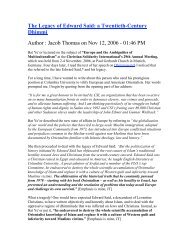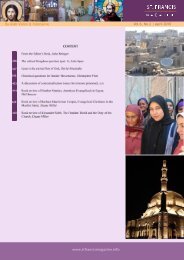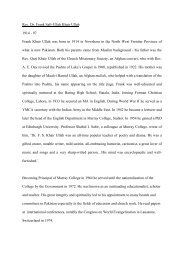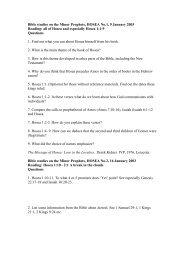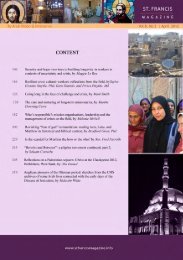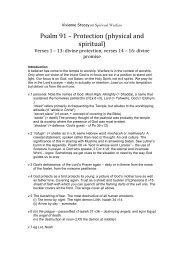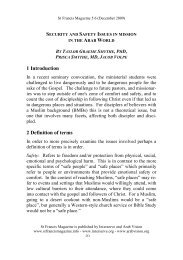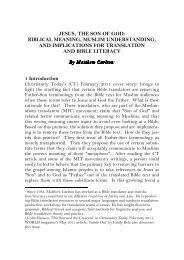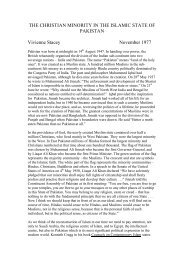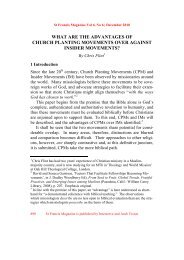download the pdf - St.Francis Magazine
download the pdf - St.Francis Magazine
download the pdf - St.Francis Magazine
Create successful ePaper yourself
Turn your PDF publications into a flip-book with our unique Google optimized e-Paper software.
<strong>St</strong> <strong>Francis</strong> <strong>Magazine</strong> Vol 8, No 4 | August 2012<br />
(Smith 2009: 21). As Tee (2007: 5) comments, “[i]t is unusual for<br />
anyone to condemn <strong>the</strong> Christian founding fa<strong>the</strong>rs of <strong>the</strong> USA for<br />
not staying in Europe as insiders, but instead beginning a new<br />
community with religious freedom in <strong>the</strong> New [sic] World.”<br />
Although <strong>the</strong> interchange is limited, Brogden (2010) allowing<br />
Lewis to interact directly with his argument is a helpful example of<br />
more open exchanges in print. It is to be hoped that this kind of<br />
communication can help heal <strong>the</strong> past regarding <strong>the</strong> abuse of confidential<br />
field studies (cf. Massey 2004c: 303), and enable new engagement<br />
and disclosure. Perhaps third-party-governed and crossdisciplinary<br />
exchanges will be even more useful. It might well be<br />
that such exchanges are already happening at conferences: seeing<br />
more of <strong>the</strong>m appearing in published form would be more widely<br />
beneficial, especially for cross-disciplinary interactions.<br />
Third, and again following on from previous observations <strong>the</strong>re<br />
is a need for better <strong>the</strong>orisation: Some already wish to set aside <strong>the</strong> C-<br />
spectrum as being frequently misunderstood and misapplied (e.g.<br />
<strong>St</strong>ringer 2007). Dixon (2009: 8-18) raises serious concerns about<br />
‘<strong>the</strong> illusion of <strong>the</strong> spectrum,’ asking whe<strong>the</strong>r <strong>the</strong> C-spectrum is<br />
over-worked and not appropriate for <strong>the</strong> tasks and claims asked of<br />
it. Its “purpose”, according to Travis (1998a: 407) was “to assist<br />
church planters and Muslim background believers to ascertain<br />
which type of Christ-centered communities [sic] may draw <strong>the</strong><br />
most people from <strong>the</strong> target group to Christ and best fit in a given<br />
context.” As such, however, it claims to offer a comparative and<br />
even critical function but, in and of itself, does not move beyond <strong>the</strong><br />
descriptive. This is evident both internally and externally.<br />
Internally, <strong>the</strong> spectrum has long struggled with C6. C6 has<br />
been <strong>the</strong> soft underbelly for C5 proponents: does it, or does it not,<br />
constitute a range of strategies / motivations in and of itself Tennent<br />
considered that C6 should be understood as an exceptional and<br />
tragic circumstance which – one day, with <strong>the</strong> decline of persecution<br />
– should become a thing of <strong>the</strong> past and, as such, should not be<br />
viewed as an extension to <strong>the</strong> contextualisation scale (Tennent<br />
2006: 102, 114n10). This cannot be assumed, however; C6 is a<br />
strategy which might be adopted by any individual within any cul-<br />
<strong>St</strong> <strong>Francis</strong> <strong>Magazine</strong> is a publication of Interserve and Arab Vision 484




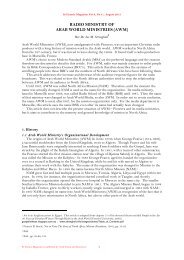
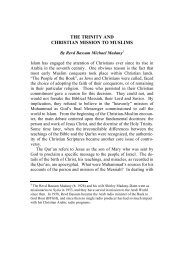
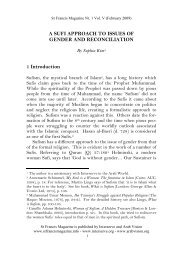
![Reflections on Surah Fatiha and the Lord's Prayer[1] - St.Francis ...](https://img.yumpu.com/49377951/1/184x260/reflections-on-surah-fatiha-and-the-lords-prayer1-stfrancis-.jpg?quality=85)
